Abstract
From ab initio quality calculations on model systems, we conclude that in unliganded Fe-porphyrin the FE lies in the plane for both the high-spin (q) and intermediate-spin (t) states. Thus, the high-spin d6 Fe is not too big to fit into the porphyrin plane (as often suggested). We find the q state lower for a porphyrin hole radius greater than 1.94 A and the t state lower for smaller sizes. For the five-coordinate complex including an axial nitrogenous ligand [a model for myoglobin (Mb) and hemoglobin (Hb)], we find the ground state to be q with the Fe 0.3 A out of the plane (recent x-ray data on deoxy Mb suggests about 0.4 A). The origin of this out-of-plane displacement is the nonbonded repulsions between the axial ligand and porphyrin nitrogen orbitals. Pushing the Fe of the five-coordinate complex into the plane does not lead to a stable low-spin state (as usually suggested), the q and t states being the low-lying states. Bonding the O2 to form the six-coordinate complex stabilizes the t form of the Mb model, leading to a singlet state of MbO2 with Fe in the plane. (It has often been suggested that the Fe of MbO2 and HbO2 is low-spin Fe2+; however, we find this not to be the case.) The bonding in the MbO2 model confirms the ozone model of the bonding, leading to a structure consistent with the Pauling model (our calculated FeOO bond angle is 119 degrees). The total charge transfer to the O2 is 0.10 electron, in disagreement with the Weiss model. Molecular orbital calculations (Hartree-Fock) incorrectly lead to septet ground state (S = 3) for the MbO2 model. The implications for the cooperative O2 binding in hemoglobin and protein modifications of the energetics of the active site are considered. Use of our calculated force constants for displacement of Fe perpendicular to the heme plane suggests that the movement of the Fe upon a change in the quaternary structure from the T to the R form is only about 0.04 A toward the heme plane.
Full text
PDF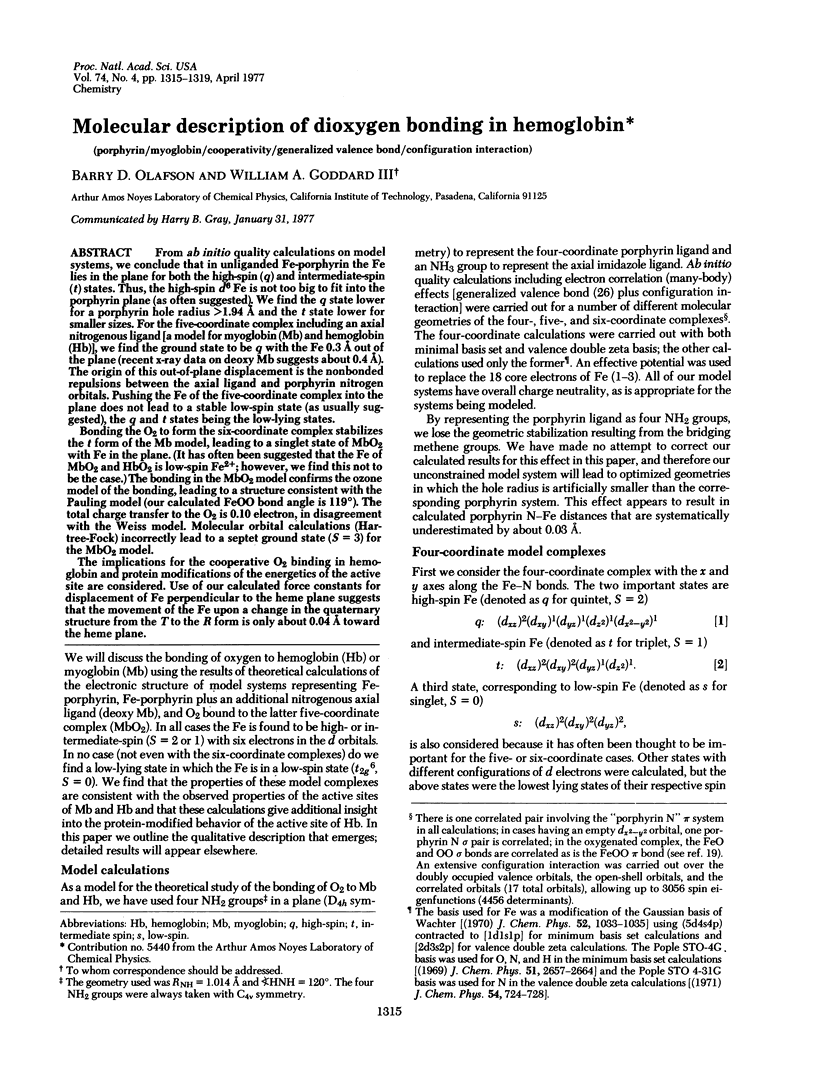
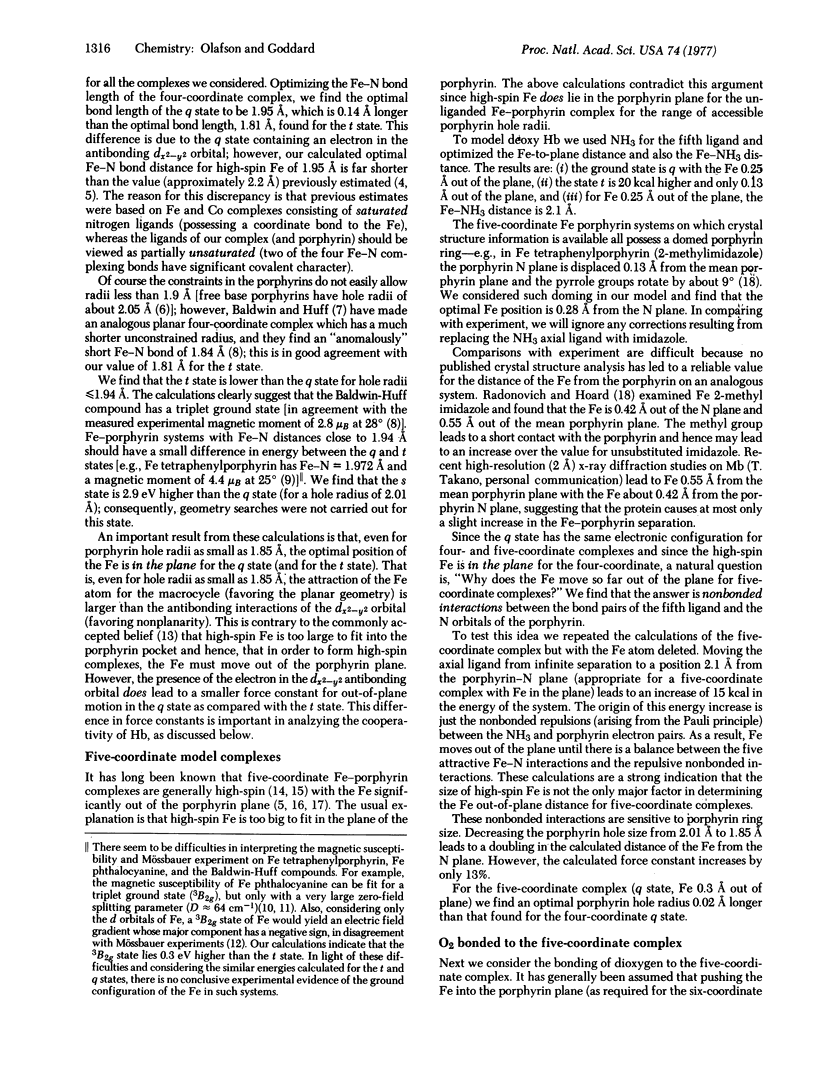
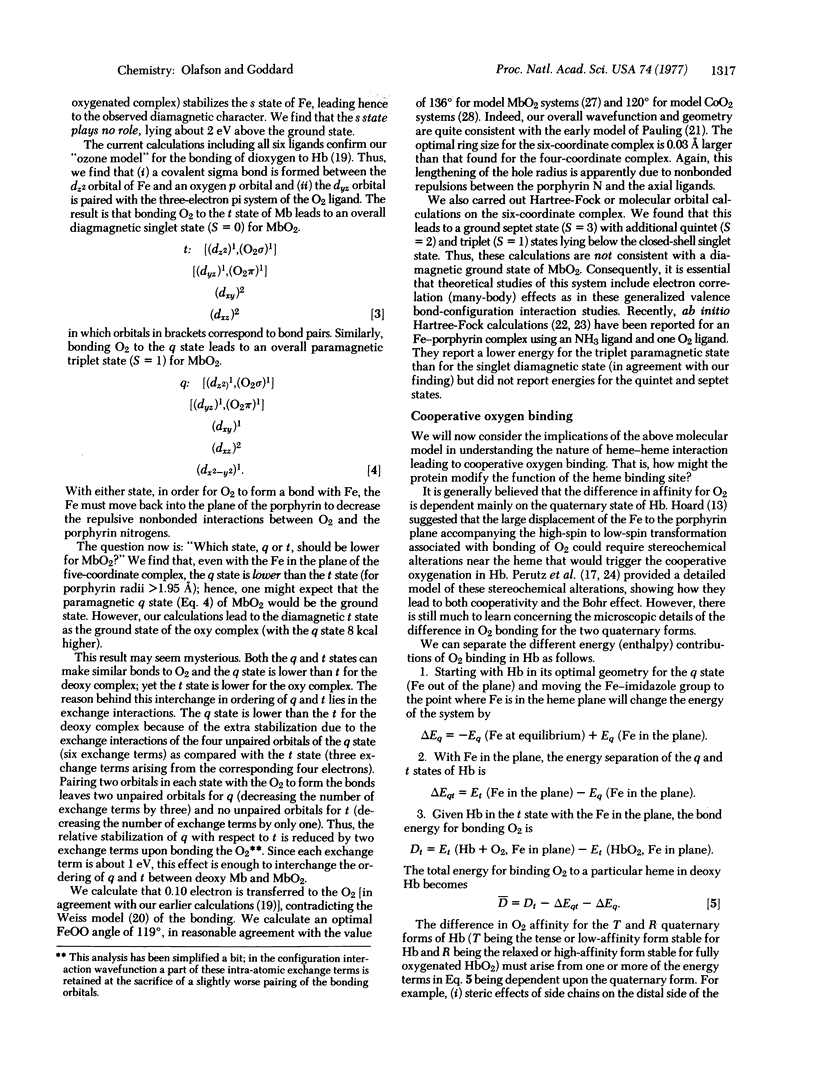
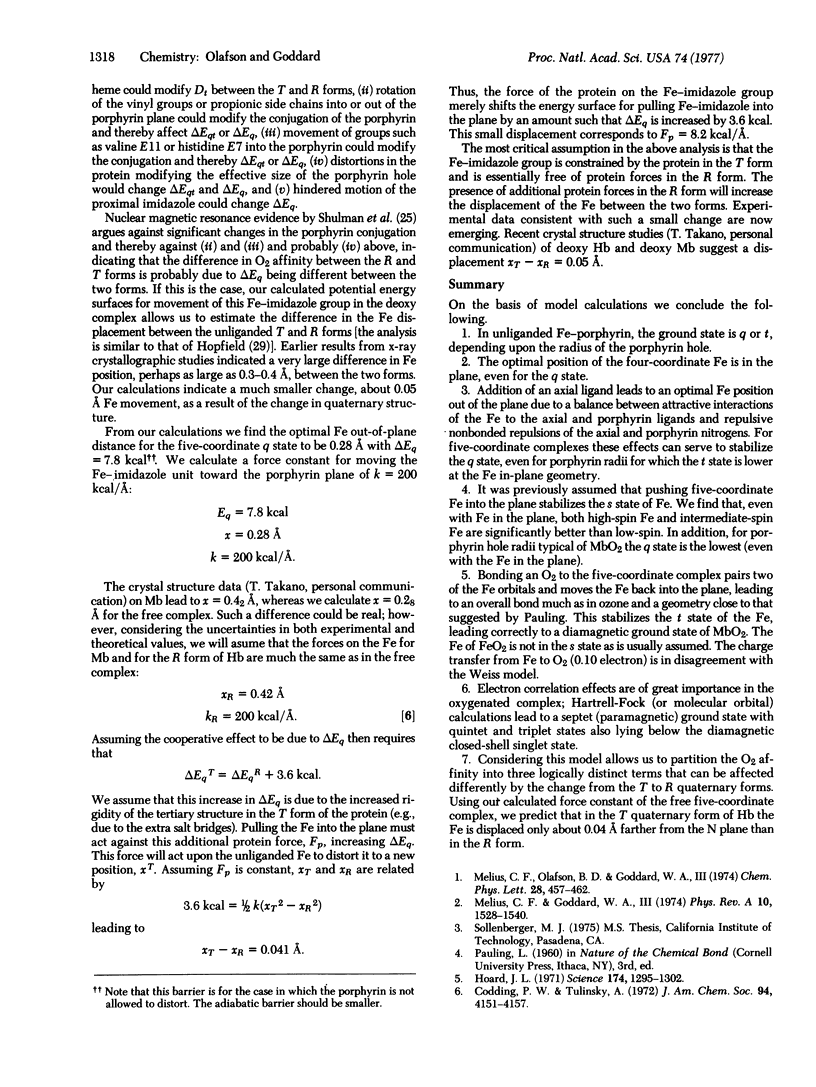
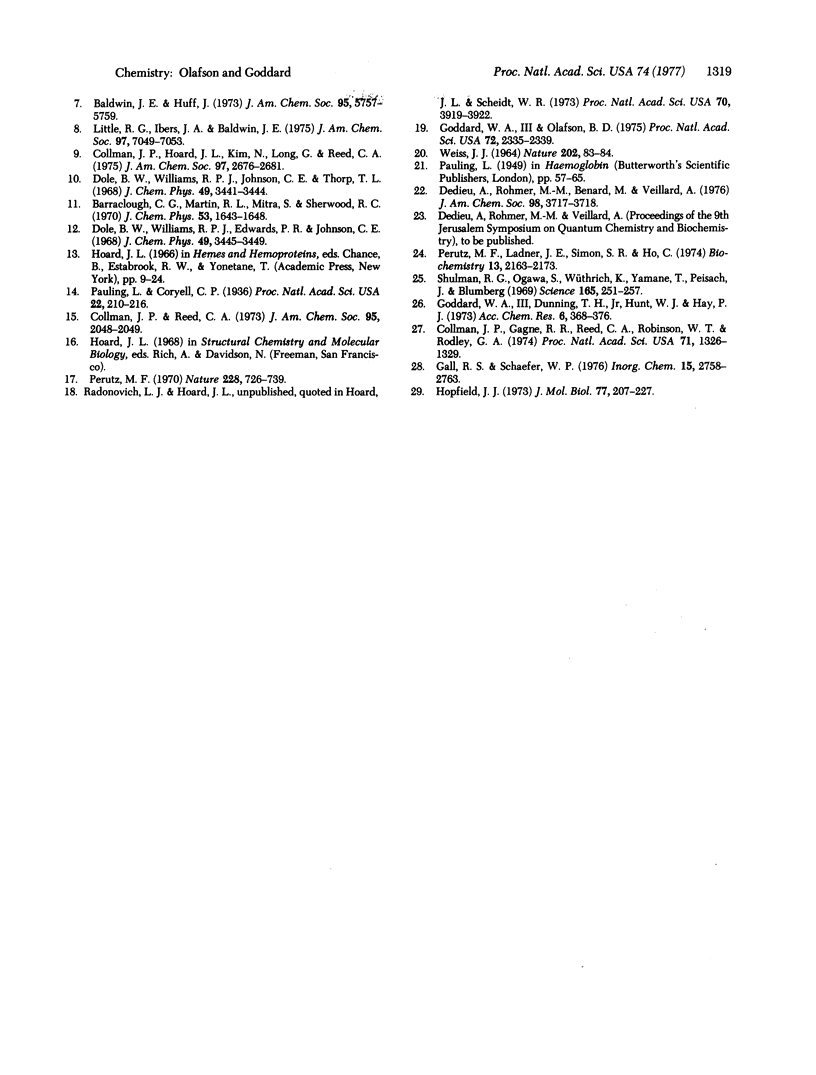
Selected References
These references are in PubMed. This may not be the complete list of references from this article.
- Baldwin J. E., Huff J. Binding of dioxygen to iron(II). Reversible behavior in solution. J Am Chem Soc. 1973 Aug 22;95(17):5757–5759. doi: 10.1021/ja00798a052. [DOI] [PubMed] [Google Scholar]
- Codding P. W., Tulinsky A. Structure of tetra-n-propylporphine. An average structure for the free base macrocycle from three independent determinations. J Am Chem Soc. 1972 Jun 14;94(12):4151–4157. doi: 10.1021/ja00767a016. [DOI] [PubMed] [Google Scholar]
- Collman J. P., Gagne R. R., Reed C. A., Robinson W. T., Rodley G. A. Structure of an iron(II) dioxygen complex; a model for oxygen carrying hemeproteins. Proc Natl Acad Sci U S A. 1974 Apr;71(4):1326–1329. doi: 10.1073/pnas.71.4.1326. [DOI] [PMC free article] [PubMed] [Google Scholar]
- Collman J. P., Hoard J. L., Kim N., Lang G., Reed C. A. Synthesis, stereochemistry, and structure-related properties of alpha, beta, gamma, delta-tetraphenylporphinatoiron(II). J Am Chem Soc. 1975 May 14;97(10):2676–2681. doi: 10.1021/ja00843a015. [DOI] [PubMed] [Google Scholar]
- Collman J. P., Reed C. A. Syntheses of ferrous-porphyrin complexes. A hypothetical model for deoxymyoglobin. J Am Chem Soc. 1973 Mar 21;95(6):2048–2049. doi: 10.1021/ja00787a075. [DOI] [PubMed] [Google Scholar]
- Dedieu A., Rohmer M. M., Benard M., Veillard A. Letter: Oxygen binding to iron porphyrins. An ab initio calculation. J Am Chem Soc. 1976 Jun 9;98(12):3717–3718. doi: 10.1021/ja00428a060. [DOI] [PubMed] [Google Scholar]
- Goddard W. A., 3rd, Olafson B. D. Ozone model for bonding of an O2 to heme in oxyhemoglobin. Proc Natl Acad Sci U S A. 1975 Jun;72(6):2335–2339. doi: 10.1073/pnas.72.6.2335. [DOI] [PMC free article] [PubMed] [Google Scholar]
- Hoard J. L., Scheidt W. R. Stereochemical trigger for initiating cooperative interaction of the subunits during the oxygenation of cobaltohemoglobin. Proc Natl Acad Sci U S A. 1973 Dec;70(12):3919–3922. doi: 10.1073/pnas.70.12.3919. [DOI] [PMC free article] [PubMed] [Google Scholar]
- Hoard J. L. Stereochemistry of hemes and other metalloporphyrins. Science. 1971 Dec 24;174(4016):1295–1302. doi: 10.1126/science.174.4016.1295. [DOI] [PubMed] [Google Scholar]
- Hopfield J. J. Relation between structure, co-operativity and spectra in a model of hemoglobin action. J Mol Biol. 1973 Jun 25;77(2):207–222. doi: 10.1016/0022-2836(73)90332-x. [DOI] [PubMed] [Google Scholar]
- Pauling L., Coryell C. D. The Magnetic Properties and Structure of Hemoglobin, Oxyhemoglobin and Carbonmonoxyhemoglobin. Proc Natl Acad Sci U S A. 1936 Apr;22(4):210–216. doi: 10.1073/pnas.22.4.210. [DOI] [PMC free article] [PubMed] [Google Scholar]
- Perutz M. F., Ladner J. E., Simon S. R., Ho C. Influence of globin structure on the state of the heme. I. Human deoxyhemoglobin. Biochemistry. 1974 May 7;13(10):2163–2173. doi: 10.1021/bi00707a026. [DOI] [PubMed] [Google Scholar]
- Perutz M. F. Stereochemistry of cooperative effects in haemoglobin. Nature. 1970 Nov 21;228(5273):726–739. doi: 10.1038/228726a0. [DOI] [PubMed] [Google Scholar]
- Shulman R. G., Ogawa S., Wüthrich K., Yamane T., Peisach J., Blumberg W. E. The absence of "heme-heme" interactions in hemoglobin. Science. 1969 Jul 18;165(3890):251–257. doi: 10.1126/science.165.3890.251. [DOI] [PubMed] [Google Scholar]
- WEISS J. J. NATURE OF THE IRON-OXYGEN BOND IN OXYHAEMOGLOBIN. Nature. 1964 Apr 4;202:83–84. doi: 10.1038/202083b0. [DOI] [PubMed] [Google Scholar]


